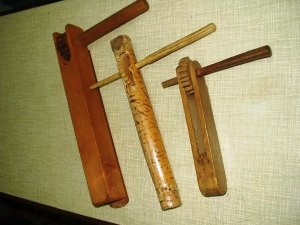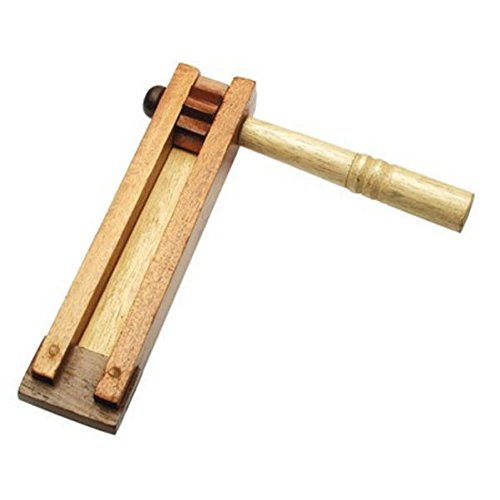
In some places a wooden gizmo with little hammers or clappers are used. In Italian they are called a “tric troc”. Other versions are handles with ratchets that you twirl around. Italians call those “raganella”.
Check with your parish priest to find out if they have a clacker or whizze r or other gizmo.
r or other gizmo.
You should probably order them in pairs, since during the Eucharistic procession to repose the Blessed Sacrament after Mass of Holy Thursday, the altar boys could alternate as they went.
They will be delighted.
To purchase…

US HERE – UK HERE Or use the Amazon search box for a “Toca T-WR Ratchet”. It is not at all expensive.
For Holy Week, the last time bells, or organ, can be rung in the Roman Rite is for the first few words of the Glo
That said, it is a strong and venerable custom that noise-makers such as the crotulus or the “tric troc”, clappers, should be used.
I cannot imagine not using some noise-maker if one is available. The association of the sounds with the Triduum are deeply part of the way we Catholics do things. They set a wholly different tone during the Triduum.
By the way, at least one church – this one in poor, poor unfortunate Malta – replaces their church bells with a really big crotalus.

































Reminds me of the toaca/semantron used in Eastern monasticism to call the monks to prayer.
https://www.youtube.com/watch?v=Isx4jc9kyEI
Good to see that the operator there is using proper PPE on his ears….
“The association of the sounds with the Triduum are deeply part of the way we Catholics do things. They set a wholly different tone during the Triduum.”
Yes yes! The strepitus, for example, at the conclusion of Tenebrae. Its striking, and sounds like an earthquake or thunder. I think it has frequently startled people in attendance who didn’t know what was coming…
I had to laugh at the rather deadpan “They will be delighted” !
I don’t often post but I always enjoy reading the blog.
May God further your work!
It could work out cheaper if you type “football rattle” in the search box – certainly the case on UK Amazon.
Any pretty-good woodworker ought to have no trouble making either of those models. St. Agnes in St. Paul on Holy Thursday…oh my!
(This woodworker will be making two of the second model for St. Wenceslaus)
Our parish does indeed have one. It’s still used.
Where I come from, devices of this sort are used to “make a joyful noise” during the annual harvest festival. Children love them!
In many catholic parts of germany the clappers or rattles are also used to substitute for the angelus ringing of the church bells. At the appropriate Times children will run through the streets with them, often while singing / shouting little rhymes.
Here is a video of a rather big one in the (german) town of Linz (Rhine): https://www.youtube.com/watch?v=BDNiCyR8MRs
For those of you who are looking for some directions for building them yourself:
Here is an austrian TV-Video of a very skilled craftsman: http://www.servustv.com/de/Medien/Fast-vergessen-Ratschenbauer
First time I saw and heard the Crotalus was at the Anglo-Catholic Episcopal Church I attended for 10 years, where I later became an altar server and got to actually use them. Then never saw them again until I started attending the Traditional Mass. Fortunately our current parish (Price of Peace Lewiston ME) still uses them for the Ordinary Form (no EF Triduum unfortunately).
I was at Mass yesterday in a very traditionally minded parish and a very traditionally minded pastor, and they already replaced the Sanctus and consecration bells with the wooden clacker.
[No no no no…]
The title of the post got my attention right away. What would I be doing with a rattlesnake? (for those unaware, Crotalus is the generic [as in genus] scientific name for the rattlesnakes, Crotalus ruber being the most impressive I’ve seen in the field). Made sense once I opened the post. It does raise an interesting idea about what you could use for Mass – someone with a snakeskin on the wall would likely have the rattle attached or nearby. Not sure how loud, but, you can’t say it isn’t a crotalus!
Father Z,
I know this is trivial to you. I was doing just fine until I scrolled down to the picture of the snake. I HATE snakes. They are the devil. They are where you least expect them like in Fr. Z’s blog. Yuk.
I belong to the FSSP parish in Minneapolis. Everything they do there is of utmost reverence and correctness. I love it.
God Bless.
Thank you for this, dear Father. It gives another example of the enduring nature of Catholic externals, even when the Faith is gone. The ratchet-rattle is mediaeval, and can still be found for sale in religious shops in French shrines, often with a holy picture printed on. In Protestant England these are known (as a correspondent notes above) as ‘football rattles’, and are used (or were in my youth) on the terraces during soccer matches, to express noisy support for one’s team. So the evil reformers corrupted objects and practices which had a religious origin.
Of course, we have the last laugh, they hear a lot of noise like this, constantly, in the eternal hot place they have taken themselves. As Fr Z would say, Go to Confession, and use your rattle for its sacred purpose!